SWELL – Strabane WwTW (2021)
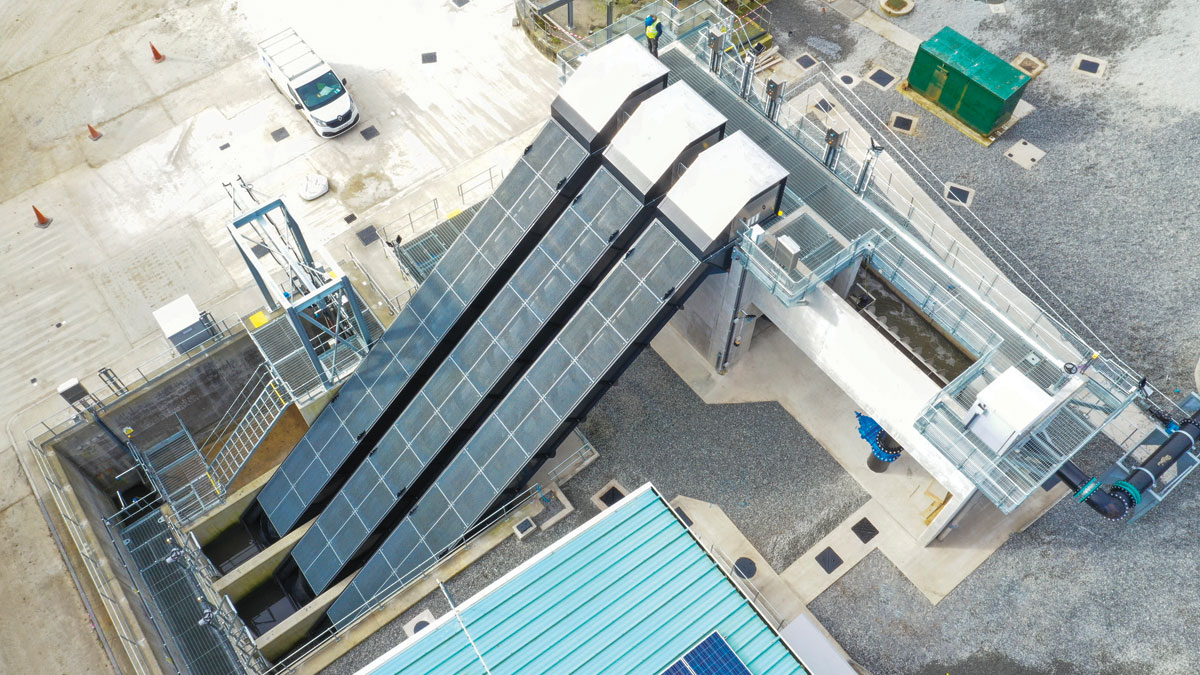
Completed installation during 28 day trial - Courtesy of BSG Civil Engineering Ltd
The Shared Waters Enhancement & Loughs Legacy (SWELL) project, funded by the EU INTERREG VA Programme, considered wastewater assets with the greatest potential to improve water quality within the Carlingford Lough and Lough Foyle drainage catchments. This included for a major upgrade to the inlet works at Strabane WwTW. In recent times, excessive flows arriving at Strabane WwTW were causing flooding of the inlet screen chamber. During prolonged storm events, this flooding would result in overtopping/bypassing of the fine screens and inlet pumping station, with the potential for discharge of raw sewage via the storm tanks to the adjacent River Foyle. Upgrade of the inlet works to better cope with peak flows arriving at Strabane WwTW has now removed a significant potential source of wastewater pollution to the Foyle Estuary.
Existing works
Strabane WwTW is located to the north-western edge of the town, adjacent to the Foyle River. The works is accessed via a laneway off the Park Road and has a total area of three hectares. The works was originally constructed in the late 1970s and since then has undergone a number of upgrades. The last major upgrade in 2004 was to serve a design population equivalent (PE) of 38,000, with treated effluent being discharged to the Foyle River via a 900mm diameter outfall pipe.
It is estimated that the existing works serves a PE of approximately 25,000, which represents significant biological underloading of the plant in comparison to its original design capacity and reflects a downturn in trade within the town in recent years. Despite this, excessive flows continue to arrive at the site during periods of heavy rainfall, due to the extent of storm sewer connections and infiltration problems within the sewerage network.
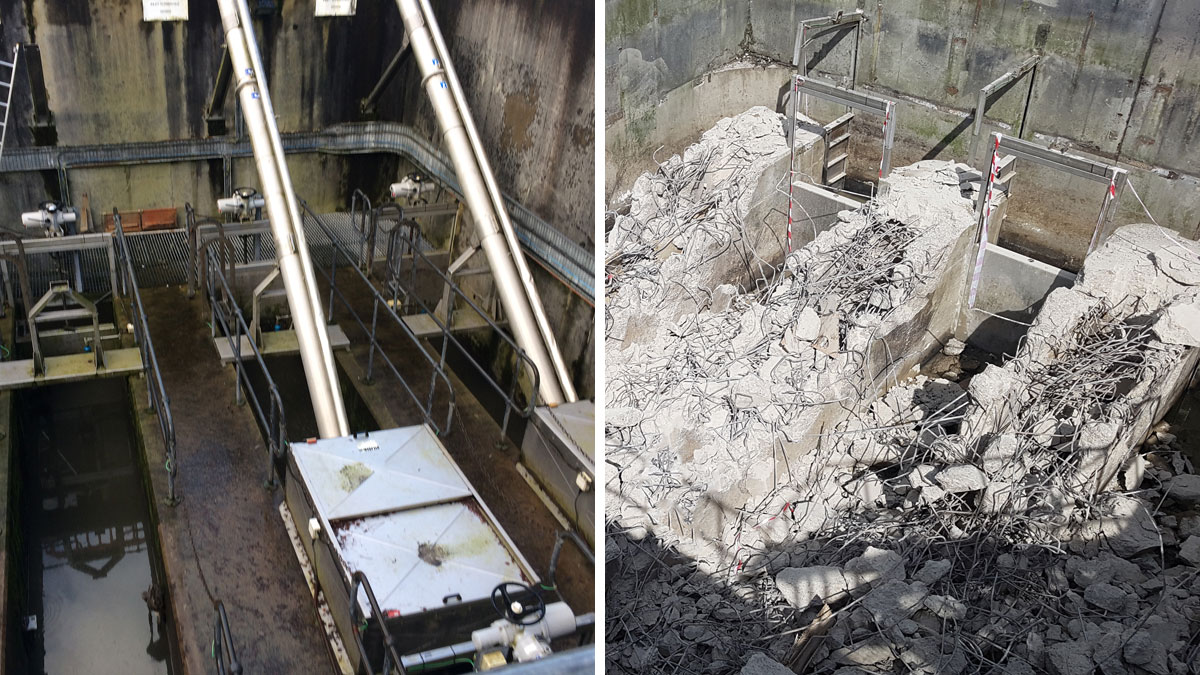
(left) Existing forebay structure with plant and equipment and (right) removal of existing equipment and demolition of the walls in the chamber – Courtesy of BSG Civil Engineering Ltd
Need for improvements
The existing foul and storm pumping station was an original structure from the 1970s that was undersized and no longer fit for purpose. Full replacement of the inlet works, including screening equipment, foul and storm pumps was therefore necessary to prevent the discharge of untreated wastewater via the storm tanks to the adjacent Foyle River. During such high flow periods, the storm tank capacity is significantly lower than the regulatory minimum storage requirement of two hours.
The solution
The upgrade to the inlet works as part of the Shared Waters Enhancement & Loughs Legacy (SWELL) Project project, provides Strabane WwTW with the ability to better deal with storm events and make it more resilient to climate change impacts. In line with the SWELL objectives, the upgrade provides additional protection to the surrounding water environment.
The variable speed screw pumps and balancing tank solution chosen was based on its capability, flexibility and reliability to serve catchment needs over a 25-year projection horizon.
The existing reinforced concrete screen chamber was modified into three separate chambers:
- Excess Formula A chamber.
- Excess Formula A overflow pumping station.
- Screw pump station forebay.
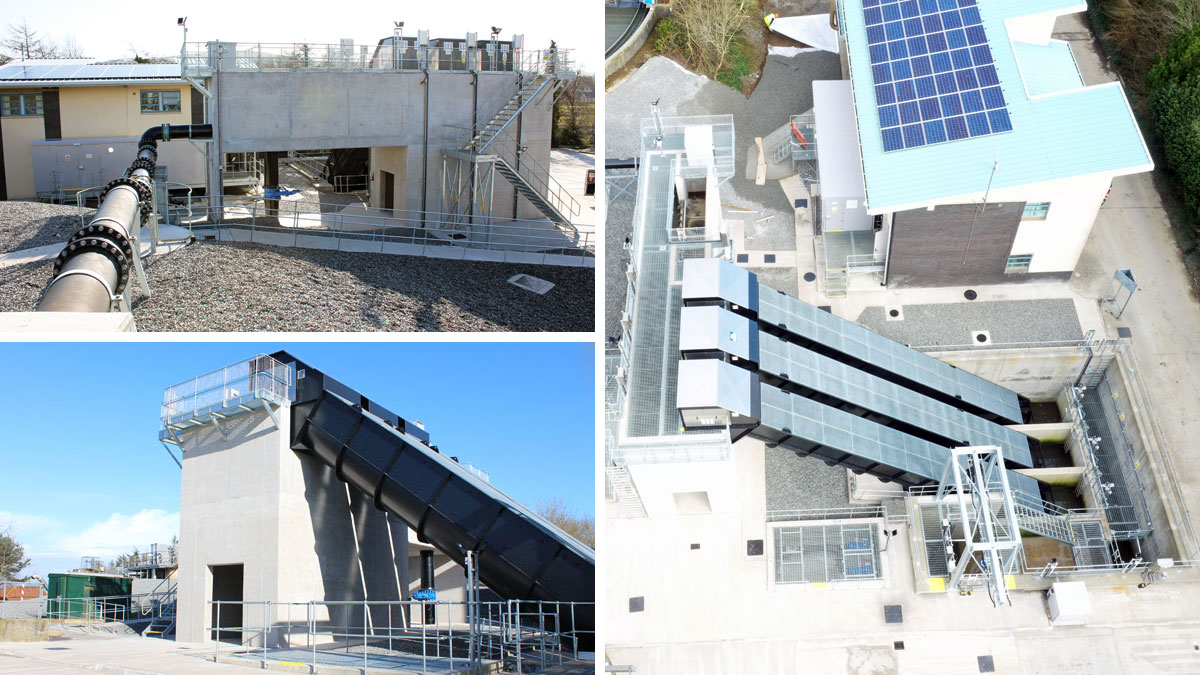
The completed installation – Courtesy of BSG Civil Engineering Ltd
The screw pump station lifts Formula A flows (500 l/s) to the existing preliminary treatment works. The screw pumps discharge into a common outlet balance/FFT channel, where flows are hydraulically separated to excess FFT flows (storm flow) and FFT flows (treatment flow) via a forward flow flowmeter/penstock. The screw pumps are capable of handling 250 l/s each, in duty/standby/assist arrangement running off variable speed drives. These screw pumps are the longest compact-style screw pumps ever manufactured by the specialist supplier Spaans Babcock Ltd.
The Excess FA pumping station contains 2 (No.) submersible pumps within the chamber, capable of handling 6mm screened influent, sized for excess Formula A flows (172 l/s) via a magmeter. This pumping station connects to the existing outfall pipe via a 400mm rising main to the River Foyle.
Flows from the new screw pumps are routed to the Formula A FFT balancing chamber. This chamber permits the screw pumps to attenuate from duty screw pump flow (250 l/s) to duty/assist pump flow (500 l/s). The FFT flow forward is restricted by a FFT control penstock, with flows forward from the balancing chamber (approximately 210 l/s) and the balance of the flows to be routed to the existing storm tanks via the 6mm storm overflow screen. Works included construction of a new gravity pipeline (600mm) from the overflow channel to the storm tanks, along with a new gravity pipeline (400mm) from the balancing chamber to the existing 6mm inlet works up front of the existing primary settlement tanks.
Strabane WwTW: Supply chain – key participants
- Client: NI Water
- Project managers: McAdam Design
- Principal designers & contractors & MEICA design: BSG Civil Engineering Ltd
- Structural & hydraulic design: Doran Consulting
- Screw pumps: Spaans Babcock Ltd
- 6mm overflow & Escamax screens: Huber Technology
- MCC: Motrol
- Access steelwork, handrail & flooring: Graham Steelwork & Engineering
- Submersible pump supplier: Xylem Water Solutions
- Boosted hose reel sets: Enisca Ltd
- Overhead gantry crane: CMCO Belfast
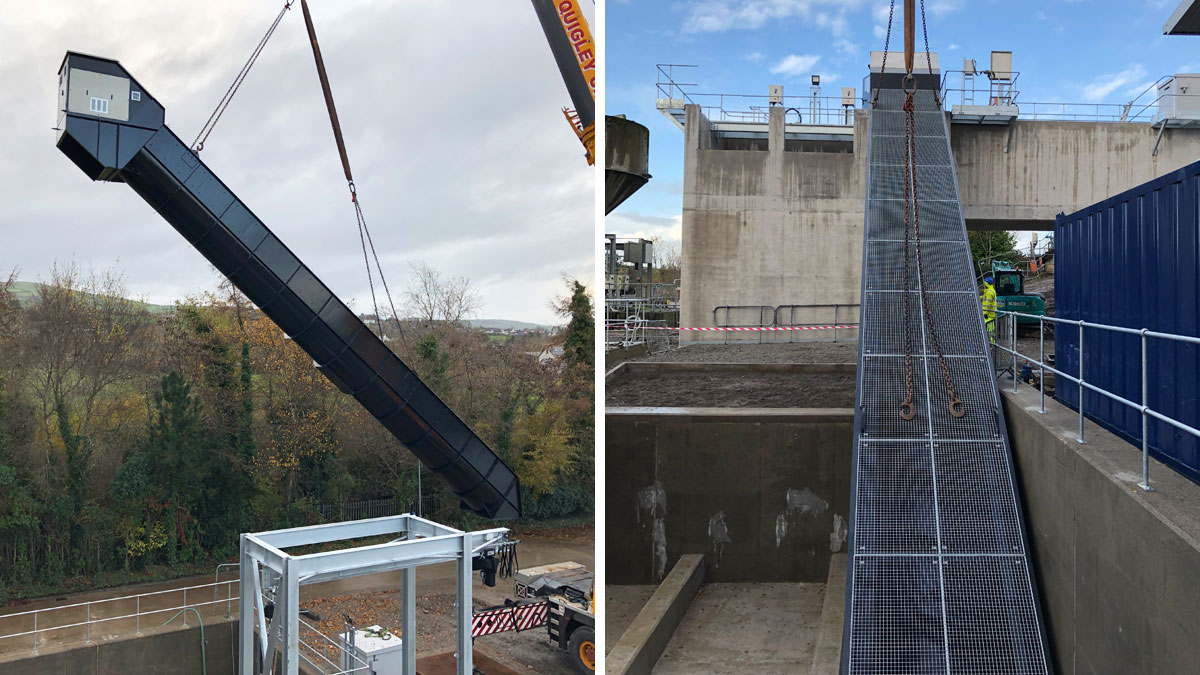
(left) Spaans Babcock Ltd screw pump being lifted in and (right) screw pump #3 in position – Courtesy of BSG Civil Engineering Ltd
Construction
Screw pump structure installation: Installation of a 900mm DI diversion pipework and manholes allowed isolation of existing reinforced concrete structure. This allowed for concrete preparation and screw pump installation to occur offline whilst all flows were diverted away from the forebay area into the existing foul pumping station.
The existing 6mm inlet screening structure was partially demolished and included the removal of existing screens, removal of metalwork including flooring and handrail, removal of existing MEICA control panel and the construction of 3 (No.) reinforced concrete baffle walls. The modification was completed through the formation of the three separate chambers; the excess Formula A chamber, the storm pumping station and the screw pump station forebay.
Balance & flow to full treatment chamber: The balance/flow to full treatment chamber is built on top of 12 (No.) 275mm x 275mm 500kN and 6 (No.) 275mm x 275mm 350kN piles. The above ground structure with height in excess of 5m included balance chamber, weir wall, access provision, outlet pipework, with the overflows delivered to the storm holding tanks.
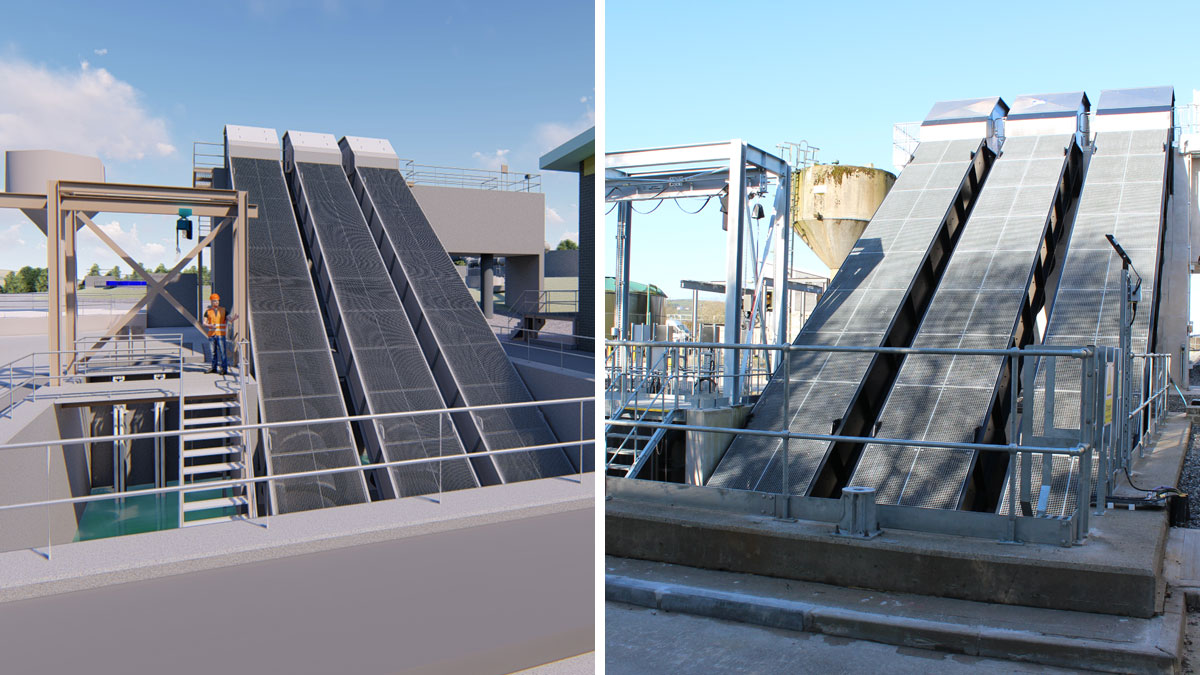
(left) 3D visualisation of screw pump structure and (right) constructed screw pump structure – Courtesy of BSG Civil Engineering Ltd
The top of the screw pumps and their enclosures rest on top of the structure. Within the enclosure lie the motor/gearboxes along with various items of screw pump condition monitoring. Downstream into the FFT channel lies an overflow screen complete with ultrasonics to screen flows that spill to the storm tanks to 6mm.
Screw pump installation: The screw pumps discharge into the common outlet balance/FFT channel, where flows are hydraulically separated to excess FFT flows, and FFT flows, via a forward flow flowmeter/penstock. The screw pumps are capable of handling 250 l/s each, in duty/standby/assist arrangement run off VSD drives. Each individual screw pump can be isolated via 600mm actuated penstock with local remote boxes for isolation.
6mm screening: An additional Escamax inlet screen was installed alongside the existing two Escamax screens, supplied under a previous scheme. Separate control panels are present for the existing two screens, with an additional new control panel being supplied for the control of the new screen (Escamax Screen 3).
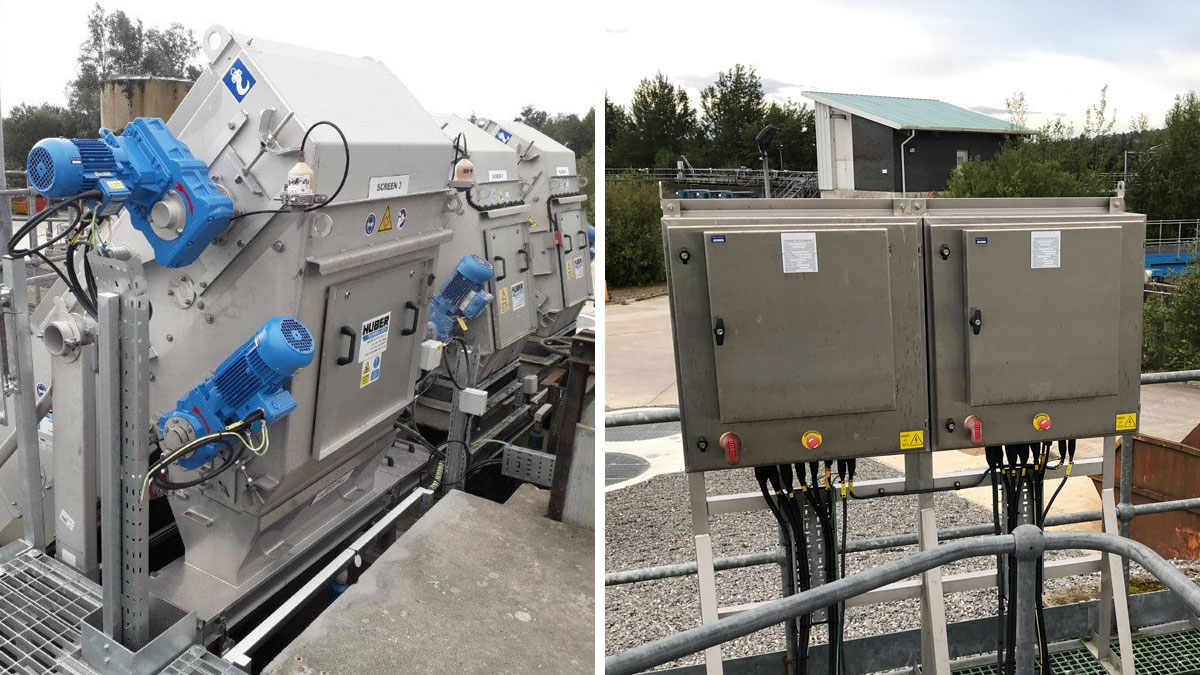
(left) New Huber Technology screens and (right) LCPs install – Courtesy of BSG Civil Engineering Ltd
Communications between the existing primary PLC and the new common control panel are via the existing Profibus, re-purposing the existing Profibus interfaces installed within the existing control panels. Screenings from the new screen exit the outlet and travel through a transition section which joins the screen to the existing launder which has been extended to allow the screenings from Screen 3 to be processed via the existing WAP.
Plant control & monitoring: The upgraded plant is designed to run fully automatically with control enacted by a single PLC housed within a common control panel/MCC of a newly installed inlet works MCC located inside a new kiosk routed adjacent to the existing primary MCC building.
Plant control and monitoring may also be accessed from the on-site SCADA PC which is situated upstairs of the main MCC building/accommodation. Plant status, alarms etc. are relayed by radio telemetry links to the NI Water central monitoring station.
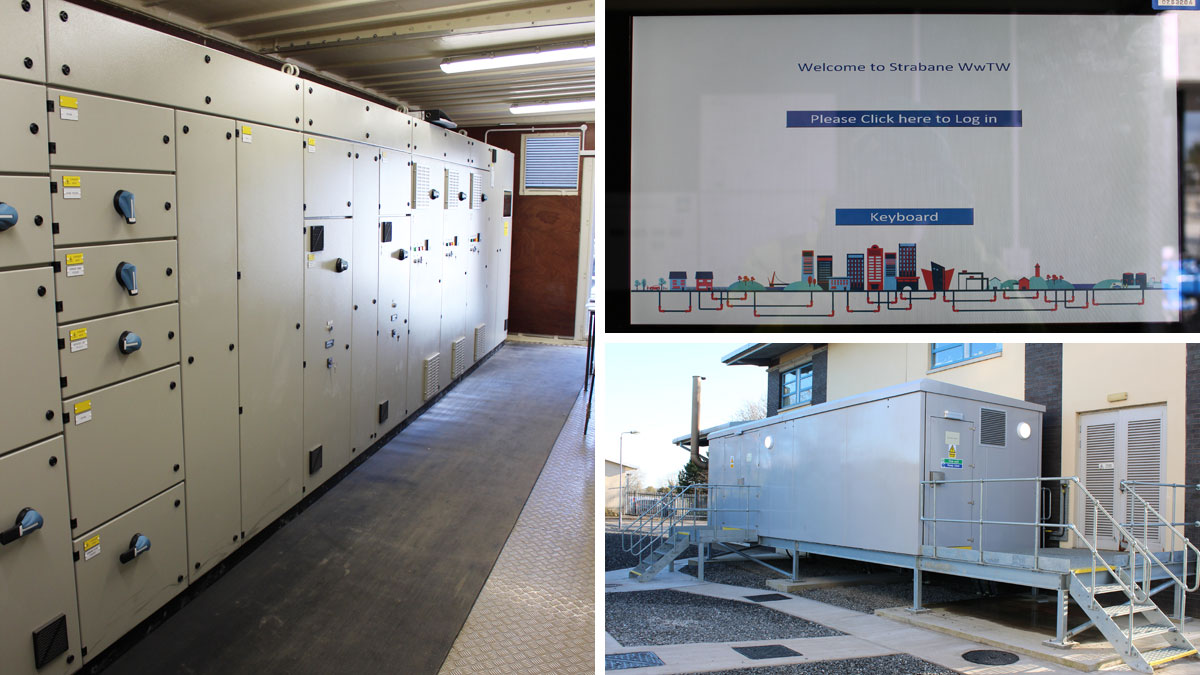
(left) New inlet works MCC, (top right) SCADA screen and (bottom right) as built MCC kiosk – Courtesy of BSG Civil Engineering Ltd
Training and handover
On 27 April 2020 and at the height of the COVID-19 pandemic, BSG Civil Engineering Ltd were in a position to complete handover of the contracted works ahead of schedule and on budget to NI Water.
With no on-site meetings allowed at the time, successful handover was achieved by BSG staff working remotely with key stakeholders to complete and review handover documentation. An innovative on-line training module, produced by BSG, allowed operators of all disciplines to be trained without the actual need to attend site.
Prior to this a successful commissioning and 28-day performance trial period was completed with excellent results achieved.
A collaborative team approach between BSG, NI Water and McAdam has produced whole life cost, programme and carbon savings. The upgraded Strabane WwTW is ensuring that high quality effluent is being discharged to the River Foyle – helping to improve the water quality in Lough Foyle in line with the SWELL project objectives.
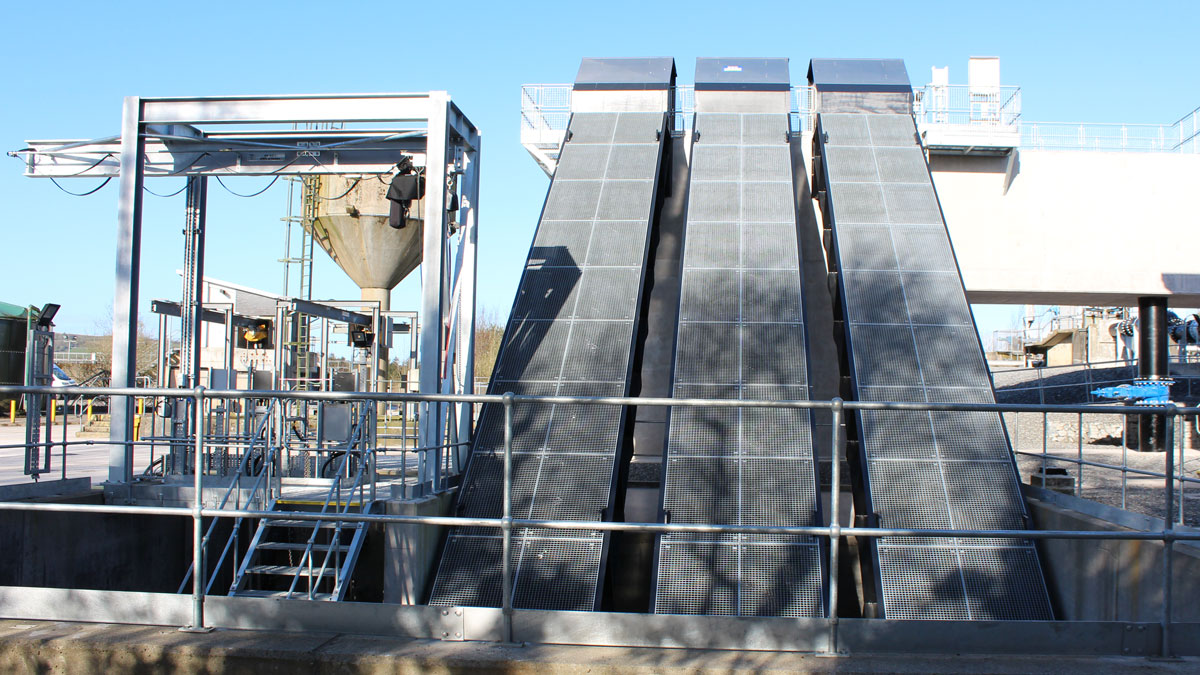
Final installation from end of altered forebay view – Courtesy of BSG Civil Engineering Ltd








